 新闻详情
新闻详情
 新闻详情
新闻详情
万双网讯 为打破学科边界,培养学生创造性思维,近日,在万科双语学校(简称VBS)八年级的人工智能课上,三位不同学科的老师,进行了创新的跨学科融合教学。课堂上三位老师打破学科边界,围绕着“语音识别——机器如何能听懂”这一主题,带领VBS未来少年一起探索语音识别的奇妙世界。
VBS News Net: In eighth grade AI class, teachers from three different subjects conducted an innovative inter-disciplinary teaching to break the boundaries among subjects and develop creative thinking. Themed on 'speech recognition - how machines could recognise', teachers led students to explore the field of speech recognition.
这节跨学科融合课由人工智能老师吴萍、语文老师郭鸾、数学老师何丹宁共同设计,教学环节围绕“融合”、“前沿”、“实践”、“体验”等核心理念展开,巧妙地将抽象、枯燥的语音识别原理类比融入到互动游戏中,参与游戏的过程就是在体验语音识别原理,对照游戏的各个环节,语音识别的原理也随之一一呈现眼前。动手实践环节——“基于Open AI集成板的Python编程调用语音识别算法”,让同学们将理论与实践相结合,学以致用,现学现用。
Co-designed by AI teacher Ms Wu, Chinese teacher Ms Glora and Mathematics teacher Mr He, this inter-disciplinary lesson focused on core ideas such as 'integration', 'front-end', 'practice', 'experience' and turned abstract speech recognition analogy into the interactive games as students got to know the principles as they played the game. Students also had the chance to practise using the algorithms based on Python in Open AI MPU to ensure students could apply.
在课堂准备的前期,三位老师对有关”语音识别“的大量论文文献进行研究、分析、拆解,并在进行跨学科课程融合的过程中,进行了大量的研讨,足量的预设和磨课。对课堂中每一个引入的理论进行了梳理,细节进行了推敲,以求能达到让孩子深入浅出地理解这个语音识别背后并不容易的数学原理。
Prior to the class, three teachers did extensive research on theses on 'speech recognition' before analysing and dissecting them. They also conducted discussions and preparation for every theory taught in the inter-disciplinary class in order to allow students to grasp mathematical principles behind speech recognition.
“在接下来的游戏中,你们每位同学将化身为一个音素……”随着郭鸾老师的引导语,同学们的积极性一下子都被调动了起来,“猜猜我是谁”游戏就这样开始了,同学们纷纷参与其中。跟着郭老师的指令,同学们依次完成写特征、猜人物、读音节、找文字等游戏环节。
'In this game, every single one of you will act as a phoneme...' guided by Ms Glora, students were excited to start the game 'guess whom I am'. Followed the guidance, students finished writing characteristics, guessing the personnel, reading phonemes and finding characters.
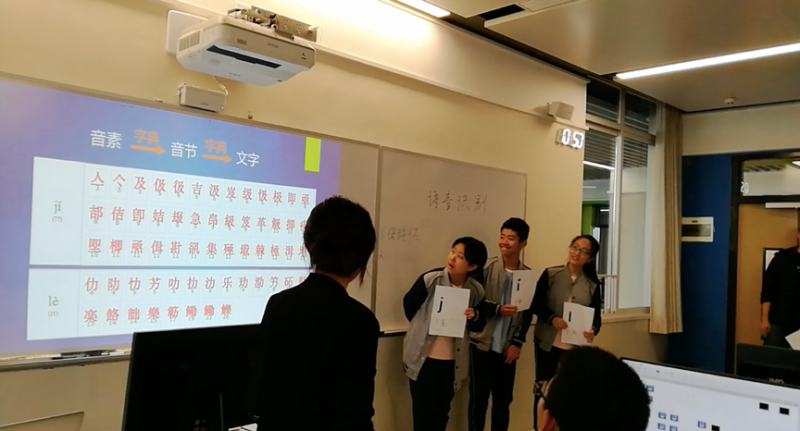
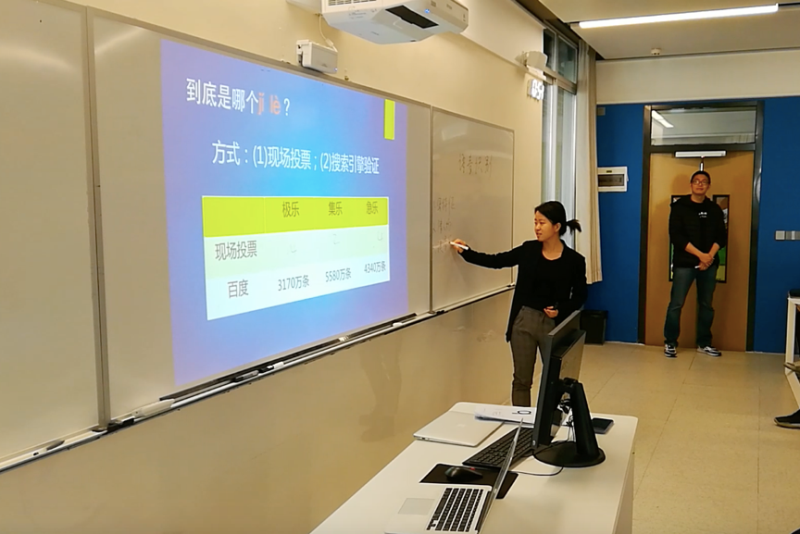
游戏是好玩,不过不知道为什么玩,在同学们一头雾水的时候,数学何丹宁老师马上为同学们揭晓谜底。语音识别原因非常抽象,难于理解,所以借着游戏的外衣,已经让同学们体会一遍游戏的各个环节了。接下来何老师依次类比游戏的各个环节,和同学们一起探索了语音识别的4个流程:特征提取、声学模型、字典、语言模型,刚刚游戏的形象化、具体化的经历,与之一一映射,瞬间让孩子们茅塞顿开,原来高大上的语音识别的原理也没有那么远在云端,也是大家能够理解的。
The game was fun but students had no clues about the reason behind it. Mr He explained the complex principles immediately after students had played all the game. He went through the game sections one by one and explored four procedures for speech recognition - characteristics retrieval, acoustic model, dictionary and language model. With the game experience, students could perceive these principles which were complicated at the first glance.
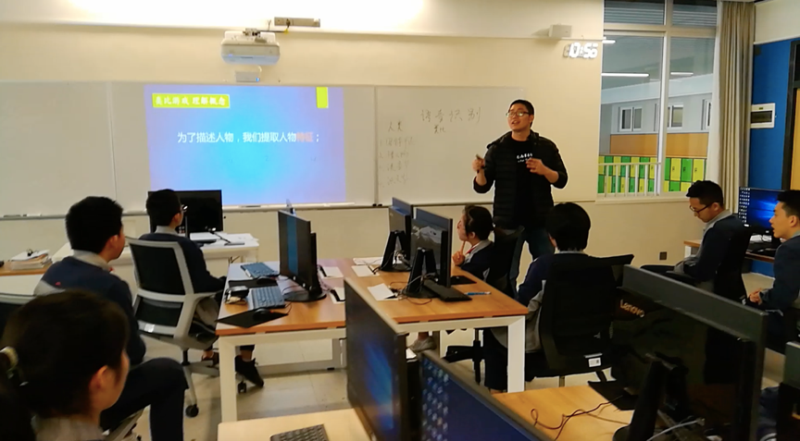
紧接着,何老师还给同学们推荐了人工智能技术原理的科普读物《数学之美》,最后带领大家一起总结本课:同学们不仅学到了语音识别的环节和原理,还感受了类比的学习方法,同时深深体会到了在AI大时代下数学的重要性。
Mr He also recommended the reading 'the beauty of Mathematics' which introduced the principles of AI. He concluded the lesson with learning technique - analogy, principles behind speech recognition and the significance of Mathematics in the AI era.
在最后的实践环节中,同学们在线体验了科大讯飞语音识别功能,并通过python语言调用识别算法的范例,体验OpenAI主控板的语音识别功能。
Finally students also tried iFlytek speech recognition function online and used Python algorithms to apply it on Open AI MPU.
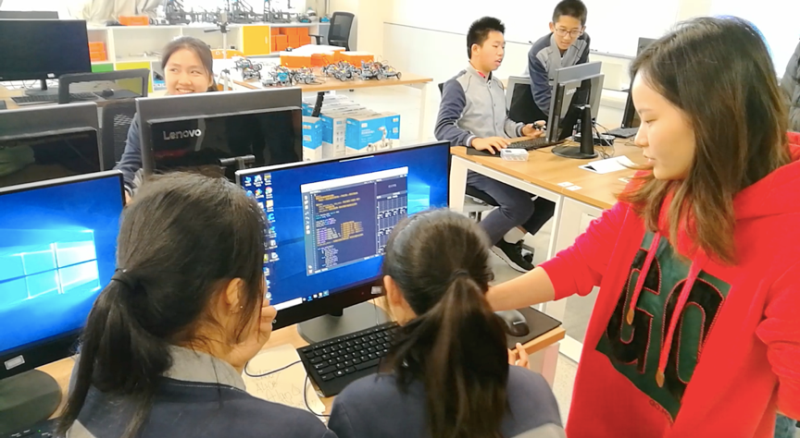
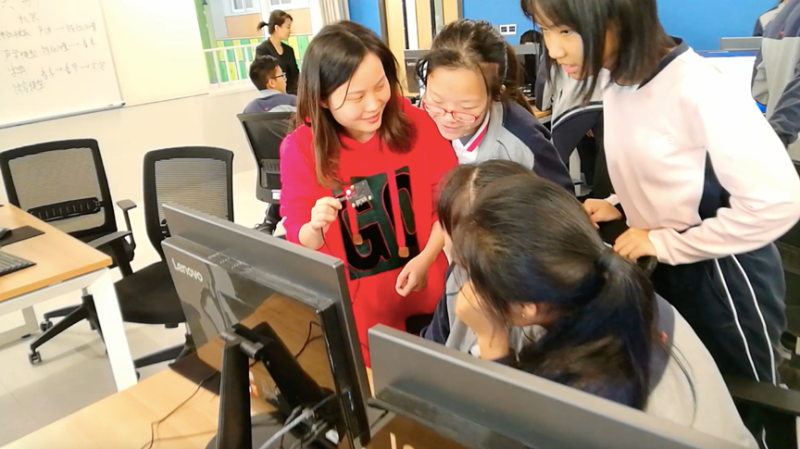
最后,吴萍老师补充道:“本次课主要介绍传统语音识别的流程,这也是初中孩子目前知识水平所能理解的。随着科技发展,语音识别算法更加复杂,尤其是神经网络的应用。为了扩大孩子们的知识面,推荐同学们课后阅读神经网络应用于语音识别的相关内容。”
Ms Wu also recommended neural networks application reading after the class on speech recognition since the algorithms could become more complex. But they had adequate knowledge to perceive traditional speech recognition process at the current level.
VBS秉承“让孩子站在未来中央”的办学理念,开设人工智能特色必修课(VBS人工智能课刚刚获得广东省一等奖),又尝试以人工智能课为跨学科融合课试点,将数学、物理、语文等与主题相关学科融入其中,旨在培养学生卓越的创造力、想象力、思维力和信息素养。这是VBS众多教学创新中的一角,相信丰富又创新的课程体系会让孩子站在未来中央。
Based on the philosophy 'Let our children experience the future', VBS initiated the compulsory elective AI class which had just been awarded the First Prize at the provincial level to conduct inter-disciplinary classes. This aimed to develop students' thinking, IT and creativity capabilities. This was just one of the innovations VBS had done and more curriculum innovation could be expected in future.
部分学生课后感言:
Students' reflections after the class
曾思阳:在上一次的跨学科课程中,我感到十分惊喜,课程内容多样,有趣,让一些挺难理解的知识点变得通俗易懂,整个流程逻辑清晰自然,学到了许多。
Zeng Siyang: I was excited to have such classes last time as it offered variety to me which was fascinating. I could understand some complex ideas and learned a lot.
窦薇薇:我对程序又有了新的理解,完全没有想象原来我们也可以做到。这次真的非常有意义,希望以后可以增加这样的跨学科形式!感谢老师,我以后会更加努力的!
Dou Weiwei: I had a better understanding on programmes and did not expect that we could do it too. This meant a lot to me and I wished I could have more lessons on this. Thanks teachers, I would work harder.
赖俊宏:在未来的生活、工作中,永远都是将已学过的知识、学科综合运用,万双的人工智能课就已经提前走到了这一步!
Lai Junhong: In future, we would always apply past learning into real life in an inter-disciplinary method. VBS AI class had already achieved this step.
尚子扬:这次跨学科学习体验中,我理解了计算机查找关键词的原理,了解了声学模型的基本结构,受益匪浅。
Shang Ziyang: In this learning, I understood the principles how computers searched key words and the strucuture of sound models.
谢慧怡:内容设置挺好,流程也不错,很nice!
Xie Huiyi: It was a nice set up, the content was great.
温思晗:跨学科AI十分有趣。从文字与数字,从语文与数学分析问题,将电脑如何听到并听懂声音一步步分解。
Wen Sihan: It was interesting to have an inter-disciplinary AI class which included question analysis from the perspectives of characters in Chinese and digits in Mathematics to computers dissecting sound.
文/郭鸾
编辑:燕子
版式:凯会
翻译:赖丁慈
Author: Glora
Editor: Linda
Formatting: Judy
Translated by DC Lai
万双网讯 为打破学科边界,培养学生创造性思维,近日,在万科双语学校(简称VBS)八年级的人工智能课上,三位不同学科的老师,进行了创新的跨学科融合教学。课堂上三位老师打破学科边界,围绕着“语音识别——机器如何能听懂”这一主题,带领VBS未来少年一起探索语音识别的奇妙世界。
VBS News Net: In eighth grade AI class, teachers from three different subjects conducted an innovative inter-disciplinary teaching to break the boundaries among subjects and develop creative thinking. Themed on 'speech recognition - how machines could recognise', teachers led students to explore the field of speech recognition.
这节跨学科融合课由人工智能老师吴萍、语文老师郭鸾、数学老师何丹宁共同设计,教学环节围绕“融合”、“前沿”、“实践”、“体验”等核心理念展开,巧妙地将抽象、枯燥的语音识别原理类比融入到互动游戏中,参与游戏的过程就是在体验语音识别原理,对照游戏的各个环节,语音识别的原理也随之一一呈现眼前。动手实践环节——“基于Open AI集成板的Python编程调用语音识别算法”,让同学们将理论与实践相结合,学以致用,现学现用。
Co-designed by AI teacher Ms Wu, Chinese teacher Ms Glora and Mathematics teacher Mr He, this inter-disciplinary lesson focused on core ideas such as 'integration', 'front-end', 'practice', 'experience' and turned abstract speech recognition analogy into the interactive games as students got to know the principles as they played the game. Students also had the chance to practise using the algorithms based on Python in Open AI MPU to ensure students could apply.
在课堂准备的前期,三位老师对有关”语音识别“的大量论文文献进行研究、分析、拆解,并在进行跨学科课程融合的过程中,进行了大量的研讨,足量的预设和磨课。对课堂中每一个引入的理论进行了梳理,细节进行了推敲,以求能达到让孩子深入浅出地理解这个语音识别背后并不容易的数学原理。
Prior to the class, three teachers did extensive research on theses on 'speech recognition' before analysing and dissecting them. They also conducted discussions and preparation for every theory taught in the inter-disciplinary class in order to allow students to grasp mathematical principles behind speech recognition.
“在接下来的游戏中,你们每位同学将化身为一个音素……”随着郭鸾老师的引导语,同学们的积极性一下子都被调动了起来,“猜猜我是谁”游戏就这样开始了,同学们纷纷参与其中。跟着郭老师的指令,同学们依次完成写特征、猜人物、读音节、找文字等游戏环节。
'In this game, every single one of you will act as a phoneme...' guided by Ms Glora, students were excited to start the game 'guess whom I am'. Followed the guidance, students finished writing characteristics, guessing the personnel, reading phonemes and finding characters.


游戏是好玩,不过不知道为什么玩,在同学们一头雾水的时候,数学何丹宁老师马上为同学们揭晓谜底。语音识别原因非常抽象,难于理解,所以借着游戏的外衣,已经让同学们体会一遍游戏的各个环节了。接下来何老师依次类比游戏的各个环节,和同学们一起探索了语音识别的4个流程:特征提取、声学模型、字典、语言模型,刚刚游戏的形象化、具体化的经历,与之一一映射,瞬间让孩子们茅塞顿开,原来高大上的语音识别的原理也没有那么远在云端,也是大家能够理解的。
The game was fun but students had no clues about the reason behind it. Mr He explained the complex principles immediately after students had played all the game. He went through the game sections one by one and explored four procedures for speech recognition - characteristics retrieval, acoustic model, dictionary and language model. With the game experience, students could perceive these principles which were complicated at the first glance.

紧接着,何老师还给同学们推荐了人工智能技术原理的科普读物《数学之美》,最后带领大家一起总结本课:同学们不仅学到了语音识别的环节和原理,还感受了类比的学习方法,同时深深体会到了在AI大时代下数学的重要性。
Mr He also recommended the reading 'the beauty of Mathematics' which introduced the principles of AI. He concluded the lesson with learning technique - analogy, principles behind speech recognition and the significance of Mathematics in the AI era.
在最后的实践环节中,同学们在线体验了科大讯飞语音识别功能,并通过python语言调用识别算法的范例,体验OpenAI主控板的语音识别功能。
Finally students also tried iFlytek speech recognition function online and used Python algorithms to apply it on Open AI MPU.


最后,吴萍老师补充道:“本次课主要介绍传统语音识别的流程,这也是初中孩子目前知识水平所能理解的。随着科技发展,语音识别算法更加复杂,尤其是神经网络的应用。为了扩大孩子们的知识面,推荐同学们课后阅读神经网络应用于语音识别的相关内容。”
Ms Wu also recommended neural networks application reading after the class on speech recognition since the algorithms could become more complex. But they had adequate knowledge to perceive traditional speech recognition process at the current level.
VBS秉承“让孩子站在未来中央”的办学理念,开设人工智能特色必修课(VBS人工智能课刚刚获得广东省一等奖),又尝试以人工智能课为跨学科融合课试点,将数学、物理、语文等与主题相关学科融入其中,旨在培养学生卓越的创造力、想象力、思维力和信息素养。这是VBS众多教学创新中的一角,相信丰富又创新的课程体系会让孩子站在未来中央。
Based on the philosophy 'Let our children experience the future', VBS initiated the compulsory elective AI class which had just been awarded the First Prize at the provincial level to conduct inter-disciplinary classes. This aimed to develop students' thinking, IT and creativity capabilities. This was just one of the innovations VBS had done and more curriculum innovation could be expected in future.
部分学生课后感言:
Students' reflections after the class
曾思阳:在上一次的跨学科课程中,我感到十分惊喜,课程内容多样,有趣,让一些挺难理解的知识点变得通俗易懂,整个流程逻辑清晰自然,学到了许多。
Zeng Siyang: I was excited to have such classes last time as it offered variety to me which was fascinating. I could understand some complex ideas and learned a lot.
窦薇薇:我对程序又有了新的理解,完全没有想象原来我们也可以做到。这次真的非常有意义,希望以后可以增加这样的跨学科形式!感谢老师,我以后会更加努力的!
Dou Weiwei: I had a better understanding on programmes and did not expect that we could do it too. This meant a lot to me and I wished I could have more lessons on this. Thanks teachers, I would work harder.
赖俊宏:在未来的生活、工作中,永远都是将已学过的知识、学科综合运用,万双的人工智能课就已经提前走到了这一步!
Lai Junhong: In future, we would always apply past learning into real life in an inter-disciplinary method. VBS AI class had already achieved this step.
尚子扬:这次跨学科学习体验中,我理解了计算机查找关键词的原理,了解了声学模型的基本结构,受益匪浅。
Shang Ziyang: In this learning, I understood the principles how computers searched key words and the strucuture of sound models.
谢慧怡:内容设置挺好,流程也不错,很nice!
Xie Huiyi: It was a nice set up, the content was great.
温思晗:跨学科AI十分有趣。从文字与数字,从语文与数学分析问题,将电脑如何听到并听懂声音一步步分解。
Wen Sihan: It was interesting to have an inter-disciplinary AI class which included question analysis from the perspectives of characters in Chinese and digits in Mathematics to computers dissecting sound.
文/郭鸾
编辑:燕子
版式:凯会
翻译:赖丁慈
Author: Glora
Editor: Linda
Formatting: Judy
Translated by DC Lai
办学理念:让孩子站在未来中央
培养(成长)目标:培养(成为)身体健康、人格健全、学力卓越,具有家国情怀和国际视野, 敢于创造美好未来的中国公民。
地址:深圳市龙华区民治街道华南路80号
电话:0755-66866333
http://vbs.vanke.com
Vanke Bilingual School, Longhua District, Shenzhen
Educational Idea: Let our children experience the future.
Training objectives: our students will become citizen of China with good physical health, sound personality, excellent academic abilities, patriotism, international vision and the courage to create a better future.
Address: No.80 Huanan Road, Minzhi Sub-district, Longhua District, Shenzhen
Contact: 0755-66866333
http://vbs.vanke.com
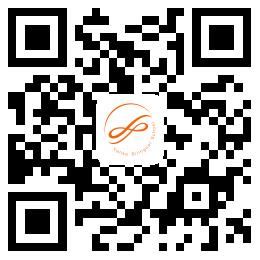
学校网站二维码
QR code of school website
学校公众号二维码
QR code of school official account